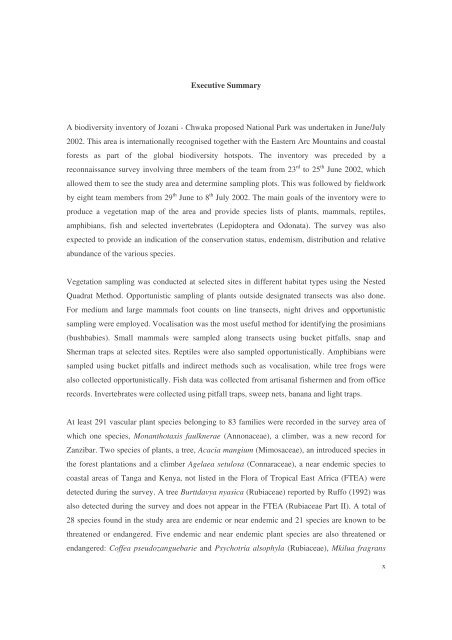Jozani biodiversity inventory report 2002 - Coastal Forests of Kenya ...
Jozani biodiversity inventory report 2002 - Coastal Forests of Kenya ...
Jozani biodiversity inventory report 2002 - Coastal Forests of Kenya ...
You also want an ePaper? Increase the reach of your titles
YUMPU automatically turns print PDFs into web optimized ePapers that Google loves.
Executive Summary<br />
A <strong>biodiversity</strong> <strong>inventory</strong> <strong>of</strong> <strong>Jozani</strong> - Chwaka proposed National Park was undertaken in June/July<br />
<strong>2002</strong>. This area is internationally recognised together with the Eastern Arc Mountains and coastal<br />
forests as part <strong>of</strong> the global <strong>biodiversity</strong> hotspots. The <strong>inventory</strong> was preceded by a<br />
reconnaissance survey involving three members <strong>of</strong> the team from 23 rd to 25 th June <strong>2002</strong>, which<br />
allowed them to see the study area and determine sampling plots. This was followed by fieldwork<br />
by eight team members from 29 th June to 8 th July <strong>2002</strong>. The main goals <strong>of</strong> the <strong>inventory</strong> were to<br />
produce a vegetation map <strong>of</strong> the area and provide species lists <strong>of</strong> plants, mammals, reptiles,<br />
amphibians, fish and selected invertebrates (Lepidoptera and Odonata). The survey was also<br />
expected to provide an indication <strong>of</strong> the conservation status, endemism, distribution and relative<br />
abundance <strong>of</strong> the various species.<br />
Vegetation sampling was conducted at selected sites in different habitat types using the Nested<br />
Quadrat Method. Opportunistic sampling <strong>of</strong> plants outside designated transects was also done.<br />
For medium and large mammals foot counts on line transects, night drives and opportunistic<br />
sampling were employed. Vocalisation was the most useful method for identifying the prosimians<br />
(bushbabies). Small mammals were sampled along transects using bucket pitfalls, snap and<br />
Sherman traps at selected sites. Reptiles were also sampled opportunistically. Amphibians were<br />
sampled using bucket pitfalls and indirect methods such as vocalisation, while tree frogs were<br />
also collected opportunistically. Fish data was collected from artisanal fishermen and from <strong>of</strong>fice<br />
records. Invertebrates were collected using pitfall traps, sweep nets, banana and light traps.<br />
At least 291 vascular plant species belonging to 83 families were recorded in the survey area <strong>of</strong><br />
which one species, Monanthotaxis faulknerae (Annonaceae), a climber, was a new record for<br />
Zanzibar. Two species <strong>of</strong> plants, a tree, Acacia mangium (Mimosaceae), an introduced species in<br />
the forest plantations and a climber Agelaea setulosa (Connaraceae), a near endemic species to<br />
coastal areas <strong>of</strong> Tanga and <strong>Kenya</strong>, not listed in the Flora <strong>of</strong> Tropical East Africa (FTEA) were<br />
detected during the survey. A tree Burttdavya nyasica (Rubiaceae) <strong>report</strong>ed by Ruffo (1992) was<br />
also detected during the survey and does not appear in the FTEA (Rubiaceae Part II). A total <strong>of</strong><br />
28 species found in the study area are endemic or near endemic and 21 species are known to be<br />
threatened or endangered. Five endemic and near endemic plant species are also threatened or<br />
endangered: C<strong>of</strong>fea pseudozanguebarie and Psychotria alsophyla (Rubiaceae), Mkilua fragrans<br />
x
















